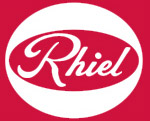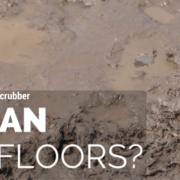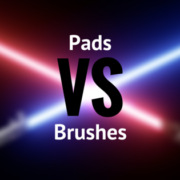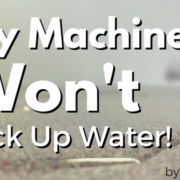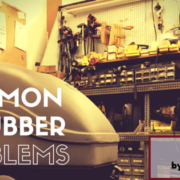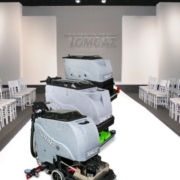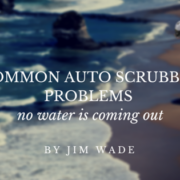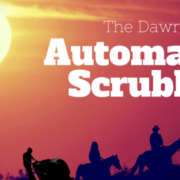Why Isn’t My Auto Scrubber Cleaning My Floors?!?
This the fourth part of a 5 part series on common problems with automatic floor scrubbers. In the past 3 I covered an overview of all problems to be discussed, a scrubber not putting water down, and when scrubbers aren’t picking water up.
My automatic floor scrubber is not cleaning the floor. We hear this too often. The brushes or pad drivers are working. The vacuum motor is working. The squeegee is down. But the floor is still dirty, streaked, dull, and sticky and just generally doesn’t look very good. So we run routine maintenance on the scrubber and we find the brushes are turning at the proper RPM and with the proper down pressure. The vacuum motor is working and has the proper CFM and Waterlift ratings. The hoses are in good shape. The gaskets are clean. The squeegee is level and we find nothing apparently wrong with the overall operation of the machine. Everything is within the manufacturer’s specifications and functioning well. So why aren’t the floors getting clean?
This is one of the most difficult problems to diagnose because the supplier of the chemical products wants to blame the equipment and the equipment supplier wants to blame the cleaning chemicals. Often times it is a combination of both. If you are purchasing an automatic scrubber for the first time you should also evaluate the type of cleaning chemicals you are using. You may need to change the chemical to get the best use out of the scrubber. This is where the knowledge and experience of your suppliers come into play. Make sure you are dealing with suppliers that can offer the education and training to achieve the results you want. Here are some things to consider.
PADS OR BRUSHES
- Make sure you are using the correct color and type of pad recommended for your floor surface. You may need to use a more or less aggressive pad to achieve the results you want. Also, check to ensure you are changing the pads frequently. Worn pads will not clean as well and may allow the pad driver bristles to poke through and damage the floor. Same goes if you are using brushes. Match the appropriate brush to your floor surface. Too aggressive and you can damage the floor. Too weak and you may not remove all the dirt. Learn more on pads vs brushes
Pad Pressure
- Make sure the machine you are using has pressure adjustments. Some scrubbers may only have 1 setting with a predetermined amount of weight on the brush. More pressure means better cleaning but be careful. Too much pressure may damage the floor. The right pressure combined with the right pad or brush may make all the difference. More pressure also means more amp draw and drain on the batteries.
Cleaning Chemicals
- Cleaning chemicals are needed to clean. They emulsify the soil and hold the dirt in suspension until the squeegee can wipe the floor and remove the dirty water. Without chemical, the floor may streak because the dirt settles too quickly back to the floor. This happens often when the user consistently uses only water to clean. The squeegee will then drag the dirt and smear the floor rather than remove the dirt. In most cases some type of cleaning chemical must be used. Check the ingredients in the chemical you are using. Some neutral cleaners contain solvents that can damage finish and coatings. Disinfectants can also damage and dull the floor. Make sure you are using the appropriate chemical in the right dilution for the floor surface you are trying to clean. Highly finished floors will require a chemical to help increase the shine. Never underestimate the use of a clean water rinse on a floor with a glossy finish. Sometimes, flooding the floor with plain water will restore the shine that has been dulled over time by the residue left behind by disinfectants and cleaners. Dirty, greasy, grimy floors may require a heavier cleaner with a higher ph level. Oily, greasy floors will need a strong degreaser that cleans but doesn’t dull or streak.
Machine maintenance
- Clean your Automatic Scrubber after each use. Clean out the tanks, debris trays, pads, brushes and especially the squeegee assembly. Dirt will accumulate inside the rear squeegee blade and harden if left to dry. This may scratch the floor surface, streak the floors, and allow trails of water to escape under the blade. This may leave unsightly streaks and discoloration on the floor. Daily auto scrubber maintenance is very important in conjunction with a strong preventative maintenance program.
Finish and coatings
- What kind of finish are you using? On vinyl tile or terrazzo, the type of finish you choose may require specific cleaning chemicals, pads or brushes. The scrubber doesn’t care what type of brushes or pads you put on it but it may make all the difference in achieving your expectations for how your floor looks. Is the polymer in the finish hard or soft? Does it require burnishing or daily scrubbing? Is it more or less tolerant to chemical usage? On concrete floors, the type of coating may also require different approaches. Is it Acrylic, Urethane or Epoxy? What type of soil is on the floor? How do you want the floor to look after scrubbing? Matching the appropriate chemical, pads, and brushes to the finish or coating is essential to achieving your desired results.
Squeegees
- If you are not getting the results you want the answer may be in what type of squeegees you have on the scrubber. Are you using Gum rubber, Urethane, Linatex or Neoprene? Maybe something else. The density of the material in the squeegees may make all the difference in the cleaning results you are getting. Make sure they are cleaned after each use to remove the dirt buildup. Also, another good idea is to wipe the blade every few minutes while you are scrubbing to ensure the buildup doesn’t occur during use.
If you are not getting the results you want from your automatic floor scrubber it may not be the fault of the scrubber. There are a lot of other factors to consider. Chemicals, finishes, coatings, pads, brushes, type of soil on the floor, squeegee material and routine maintenance are just a few of the possibilities. An experienced supplier with the knowledge and training programs you need can ensure you get the cleaning results you wish to achieve.
